Texture and dimension are signature elements of textile art. Raised stitchwork and manipulated fabrics can create visual depth in remarkable ways.
But Wendy Dolan pushes graphic dimension even further by adding print, paint and three-dimensional mediums to her layered fabrics. Stucco walls, mossy trees and crushed stones stand proud in fascinating fashion. Heavy stitching by hand and machine add further depth and movement.
Wendy is offering a look into her techniques and favourite materials, including heat-activated ‘puffing’ media. You’ll also learn how tissue paper and packaging materials can create incredible textures.
Enjoy exploring Wendy’s world where surface treatment is literally taken to new heights.
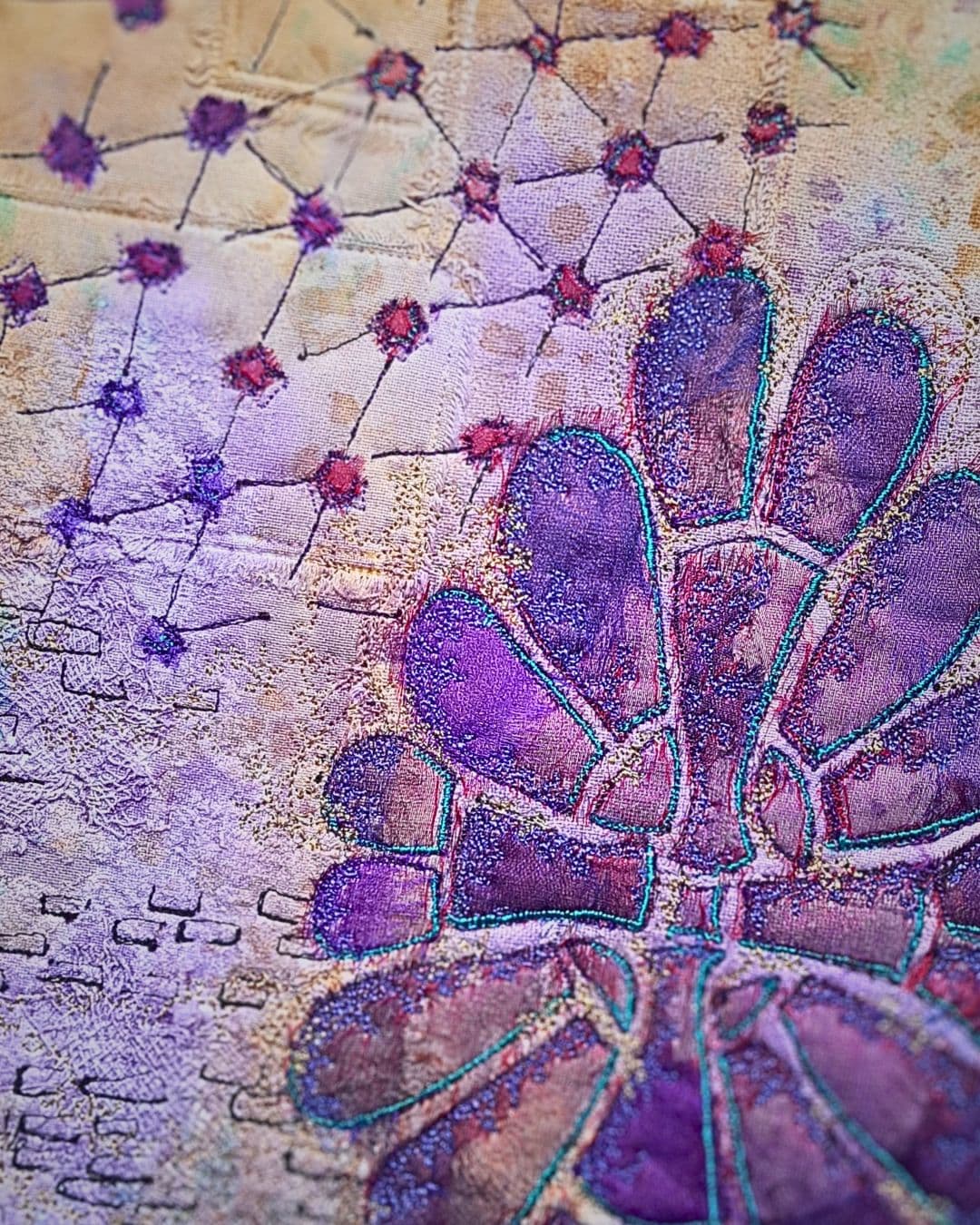
A map of London
My earliest memories of creating with fabrics was making clothes for my dolls when I was eight or nine years old. My mother always knitted and made clothes for the family, so I started to also make garments for myself.
I created my first embroidered work when I was 11. There was a small wool and haberdashery shop in the village that sold iron-on transfers. We purchased a design depicting a map of London and various UK emblems. That project started my lifetime love of stitch and textiles, and I still have the finished piece. A family friend noticed my interest in stitching and taught me many traditional hand embroidery techniques.
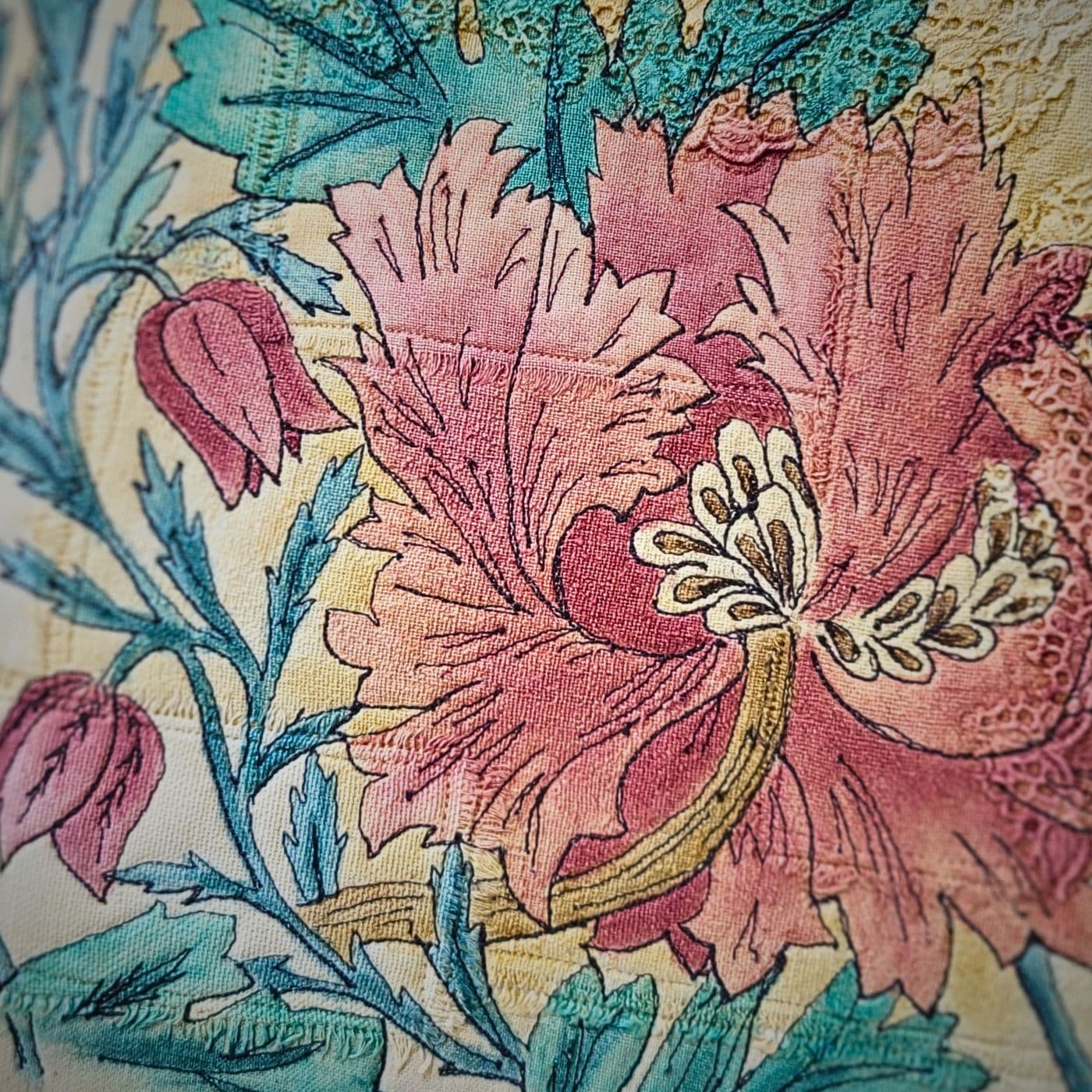
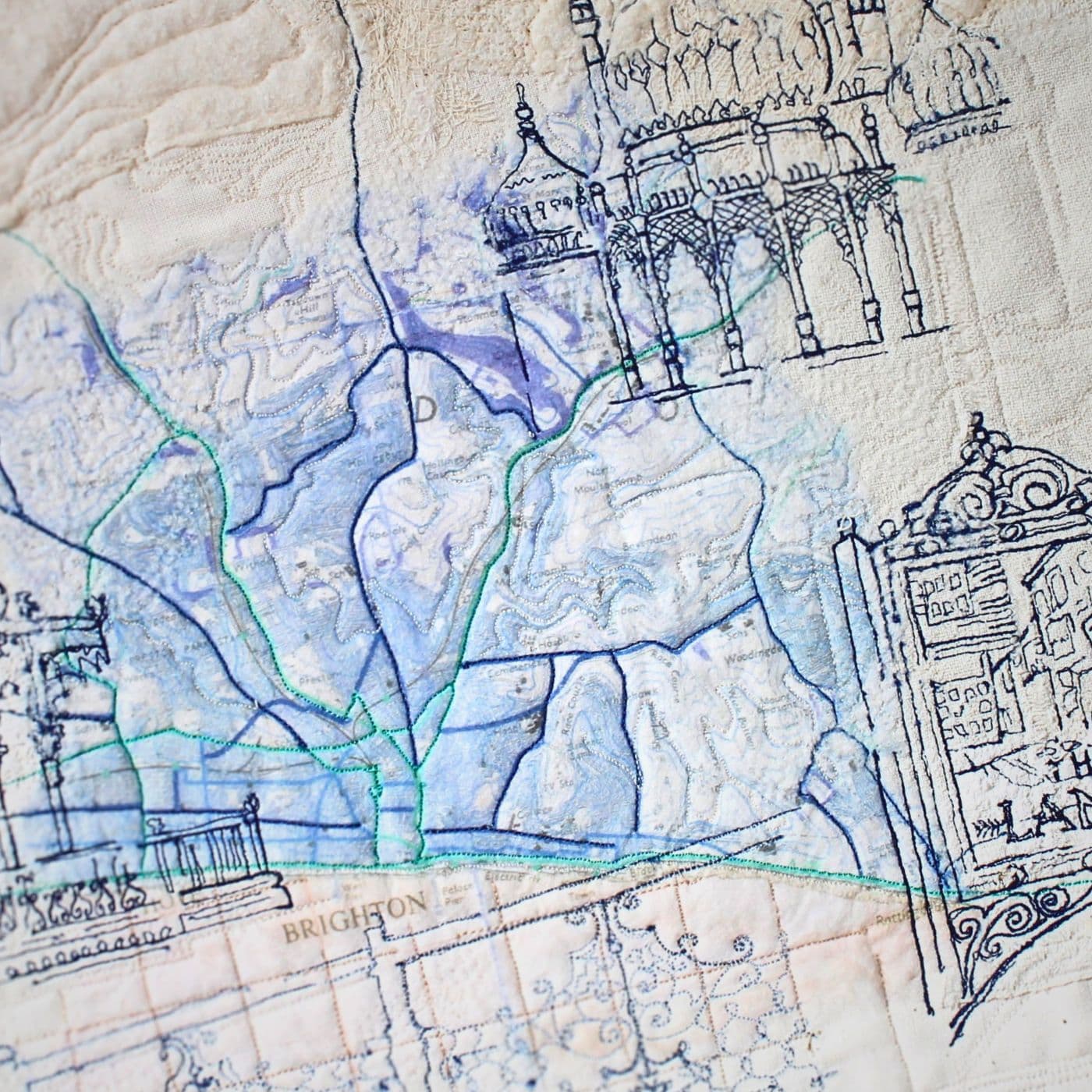
Discovering textile techniques
While studying at school for my A level, the new art teacher encouraged me to take embroidery for one of the papers. She was so supportive, taking me to London to see embroidery exhibitions while helping me develop my design work in school. I shall always be grateful for her help and encouragement.
Having decided to pursue a career in teaching, I chose a BEd course which offered Art and Textiles as a core subject. That opened a whole new world of textile techniques, including freehand machine embroidery, fabric painting, printing, machine knitting and weaving.
I soon realised I could achieve exciting textures and effects by combining a wide range of approaches, and I haven’t looked back since!
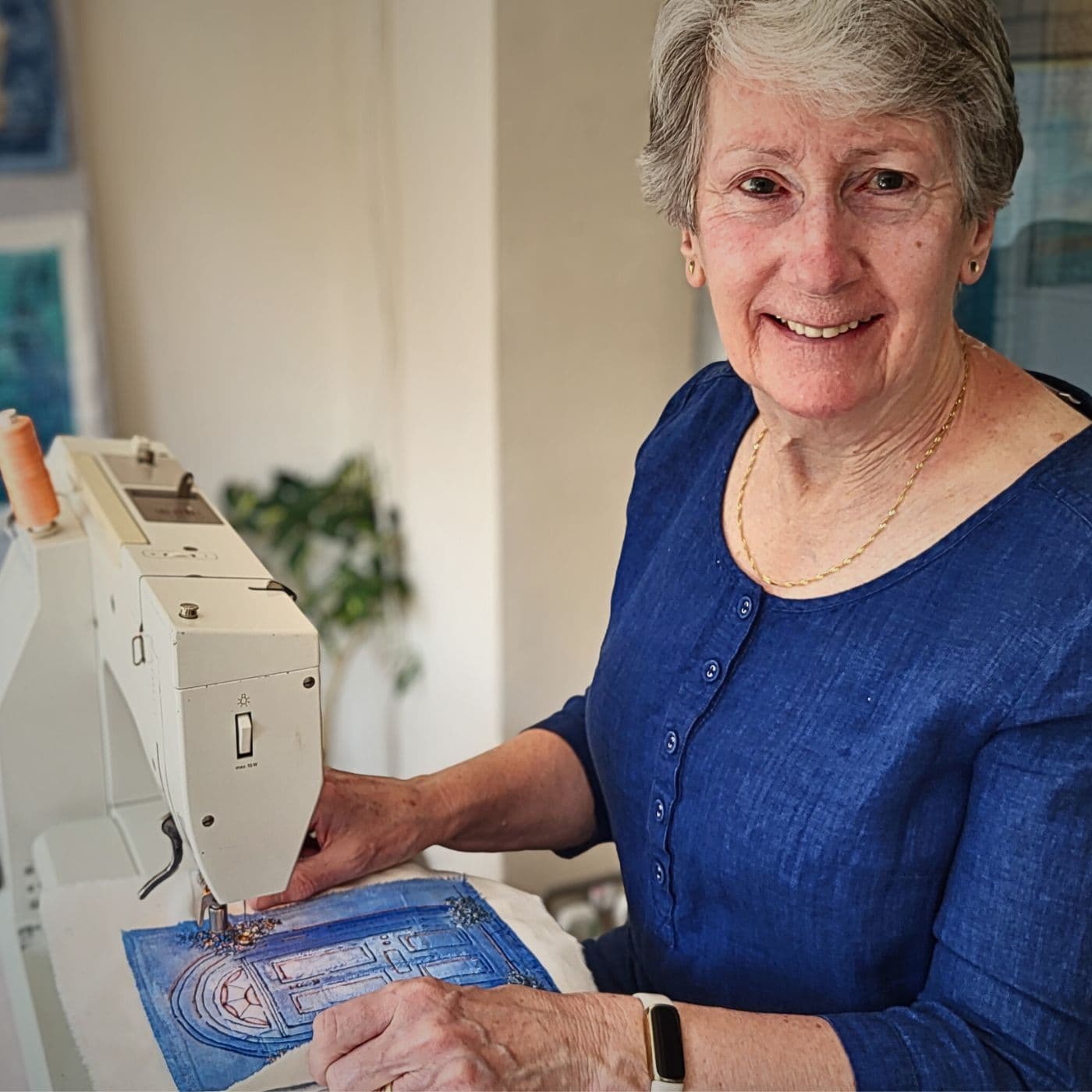
Places, maps & journeys
My inspiration comes from a variety of sources, including architecture, the landscape, still life, and maps and journeys.
I use my camera to capture images, and I record my ideas in a sketchbook. I combine pen and ink, watercolour and torn paper collage to develop my ideas and designs. I also create a torn paper collage for my colour scheme that I can use as a reference for printing and painting.
I begin a piece by exploring the design element, then experimenting with different materials.
When I’ve finalised the proportions, I select and layer my fabrics to build up the design. I choose fabrics with contrasting textures and tones and tear them to add interest to the surface. If my design is architectural, I first transfer the image onto tracing paper, so I can see where I’m placing the fabrics.
I machine stitch the layers down using cotton thread, and then I add hand stitching and three-dimensional media if it’s appropriate.
Once my surface design is prepared, I apply colour by painting and printing. Hand and machine stitch allow me to work further into the piece, making marks and textures with coloured thread. Sometimes I work intuitively and use the texture of a particular fabric to develop an idea.
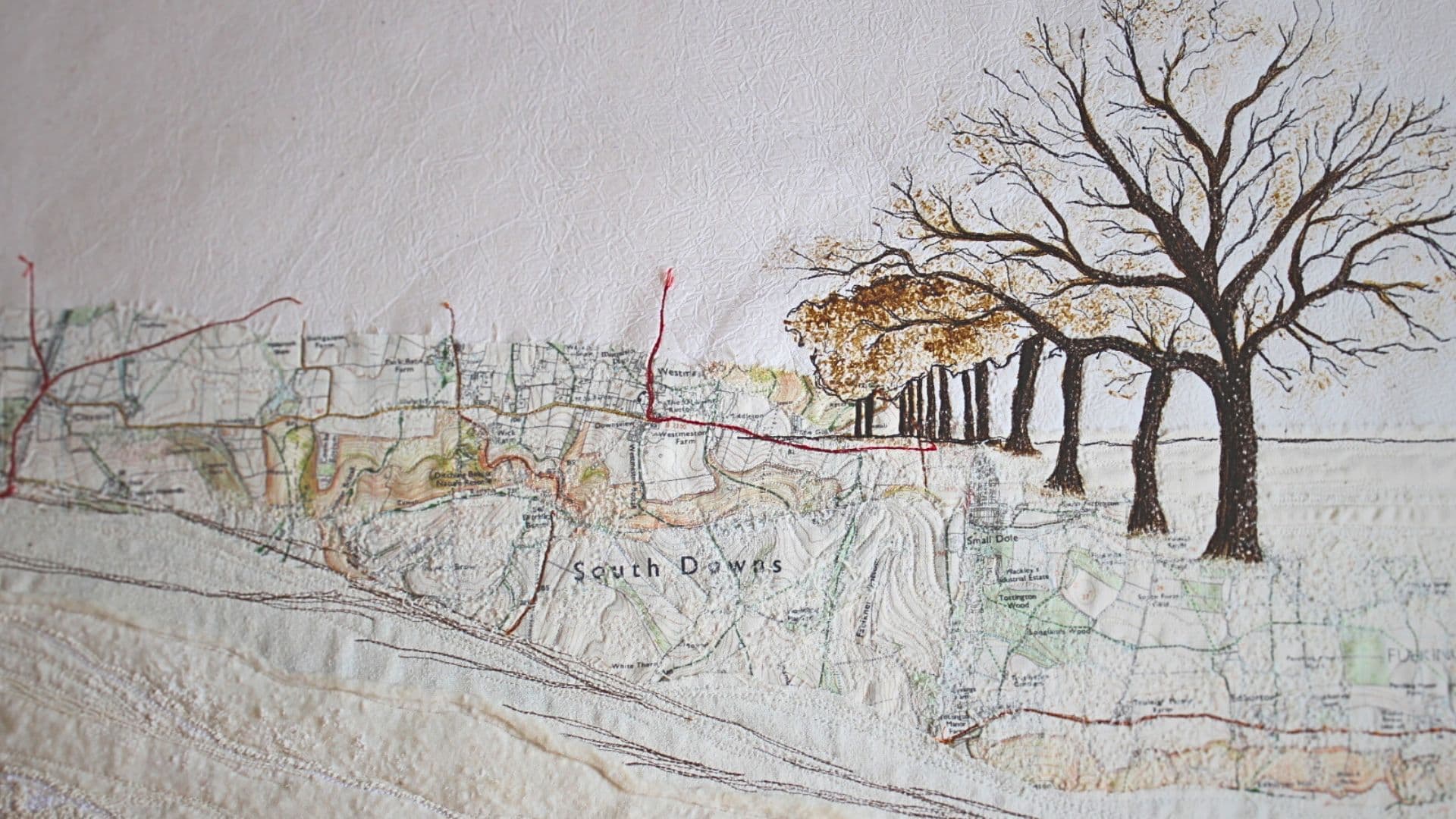
“Very often, the unexpected happens, producing more pleasing results.”
Wendy Dolan, Textile artist
Inked textures
The pigments I use are screen printing inks. I prefer the brand Sericol and have been using it for more than 45 years. I was introduced to Sericol pigments during my degree course, and I find them extremely versatile. They have a thick consistency that can be used for block printing, stenciling, mono printing, screen printing and applying with a palette knife.
The thickness of the inks gives me greater control when I apply them to my built-up designs. But because they are water-based, they can also be diluted with water and applied with a brush to create water colour effects.
When working with the inks, I usually plan the process and have a good idea of the outcome. But I always keep an open mind and I’m happy to redirect my thoughts as I progress. It’s an exciting way to work, as very often, the unexpected happens, producing more pleasing results.
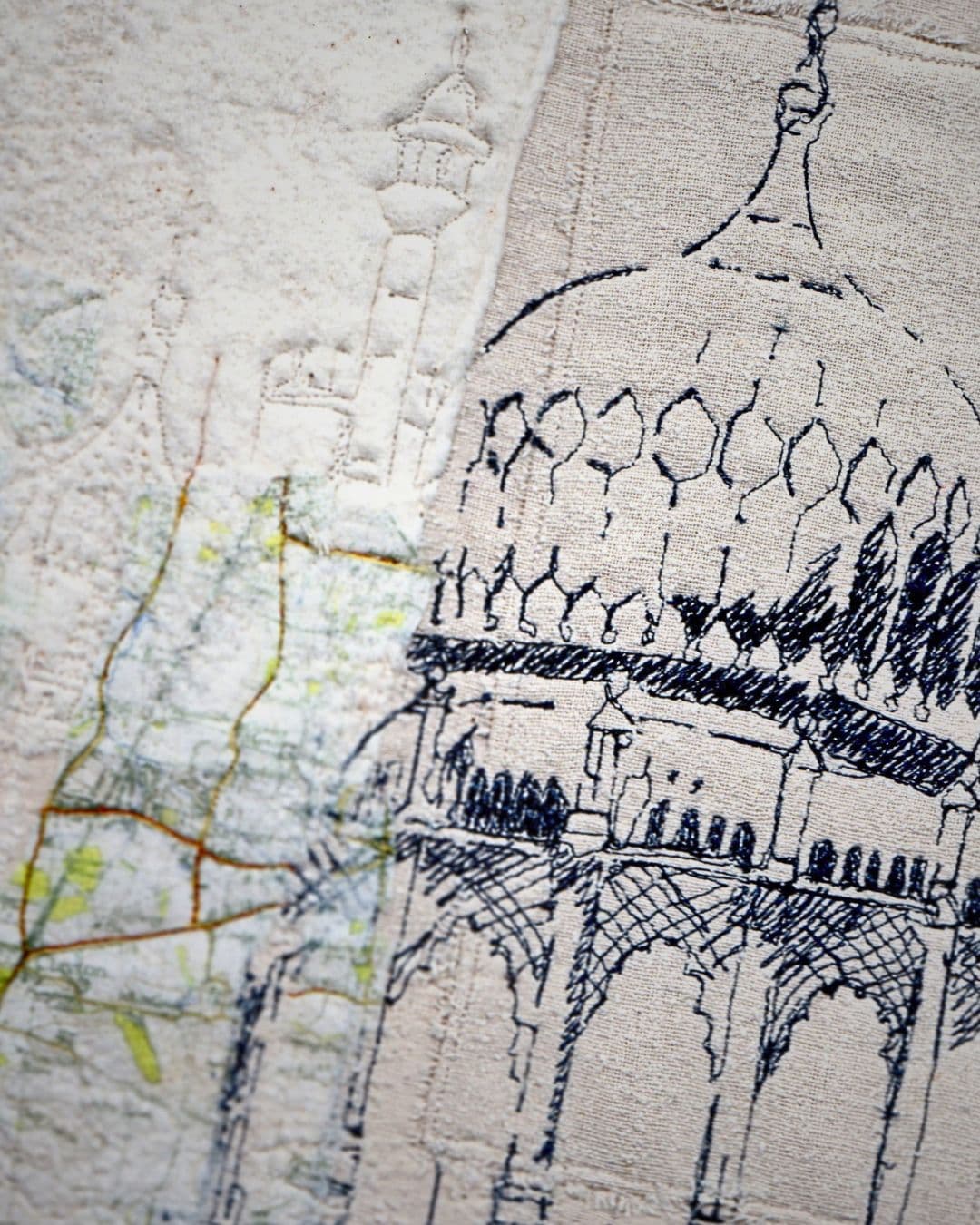
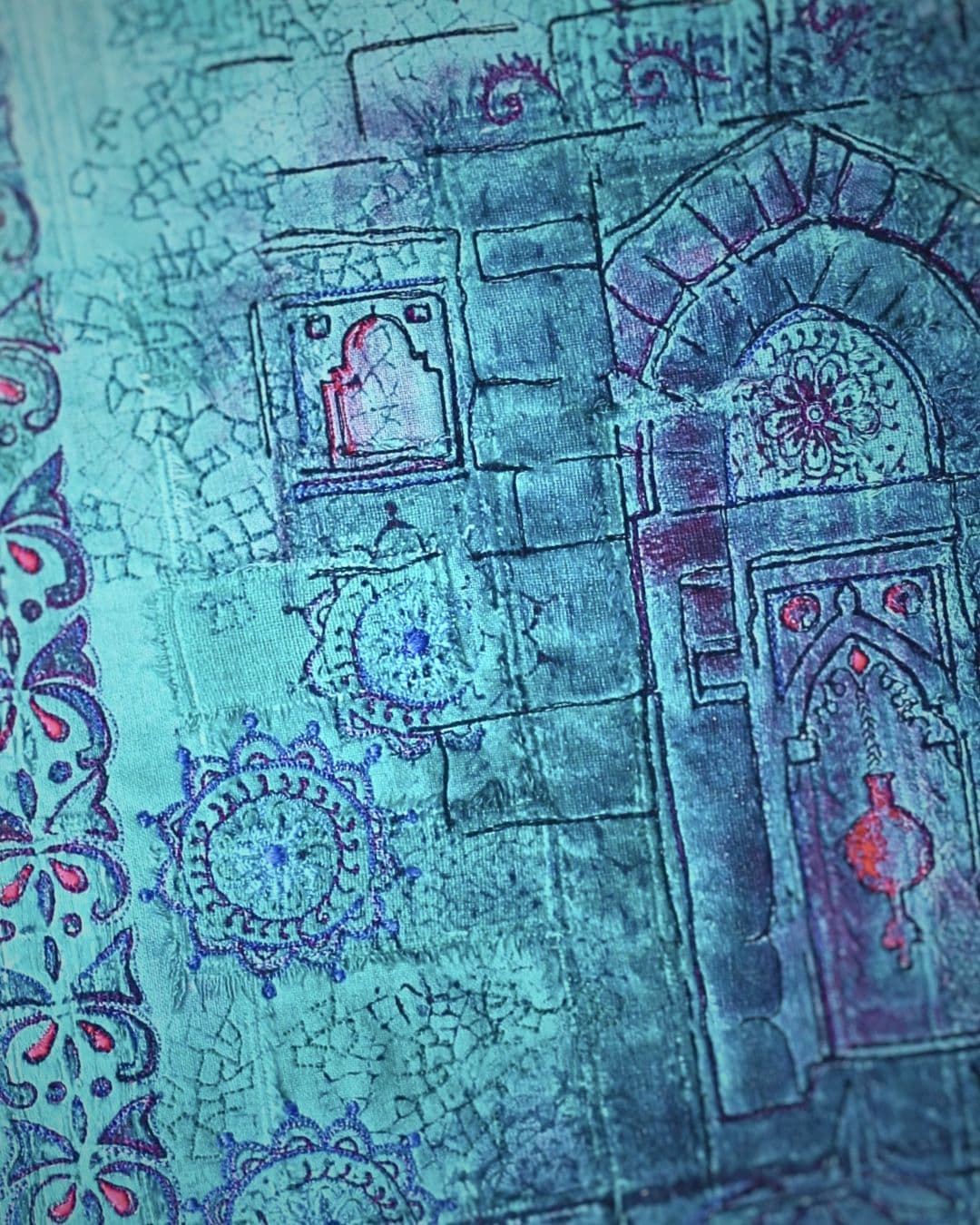
Tools of the trade
I use a ceramic tile and a palette knife to mix my inks. For printing and mark making on fabric, I use a variety of wooden printing blocks, handmade printing blocks, sponges and stencils. I’ll also sometimes use household items such as packaging, bubble wrap and corrugated card.
I apply colour using a sponge and lightly dab the block’s surface. Then I place the fabric on top of a padded surface to produce clear results when printing. A piece of thin foam or some newspaper is sufficient.
I make sure my fabrics are pre-washed to remove any dressing before creating any design. Some fabrics may soak up more colour than others, so I also always experiment with colour application before constructing a piece.
When I apply colour with a brush, I find it is easier to spray the surface lightly with water first. Printing is added after I’m done painting.
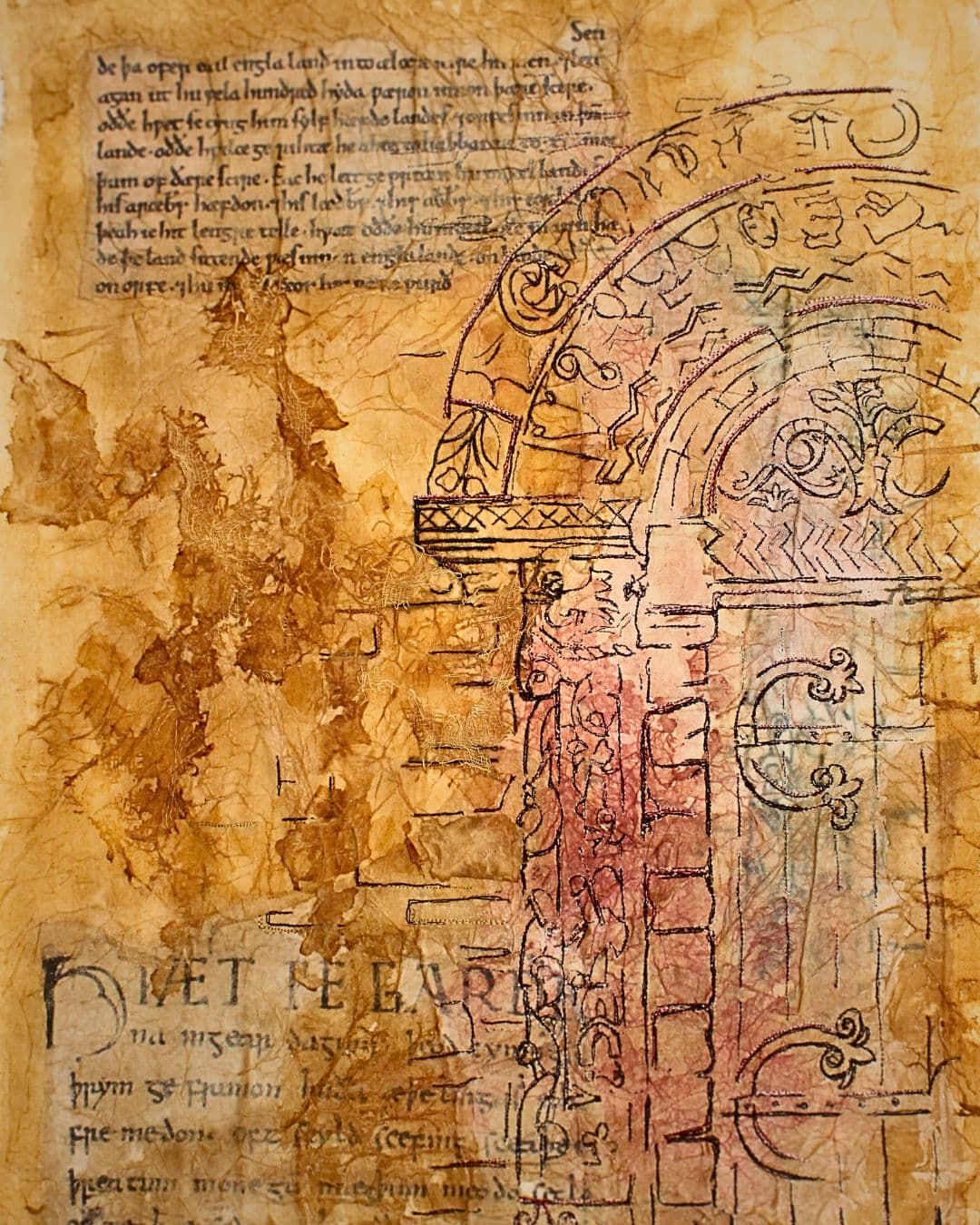
Adding dimension
I enjoy working with Xpandaprint (also sold as Expandit) to create texture and dimension. It’s a thick non-toxic medium that can be applied with a brush, roller or sponge. It expands when heated and then can be painted. I often use it to represent textured surfaces, such as crumbly walls, moss and lichen.
Occasionally, I use modelling paste. I apply it thinly with a sponge or through a stencil. It creates interesting resist effects when painted.
Incorporating tissue paper can also create interesting surface textures. I scrunch the paper in my hands and then tear it into small pieces. Then, I fuse the crumpled paper to fabric using Bondaweb or similar iron-on fusible. Finally, I paint the surface for further effect.
I used this technique to create a crumbling wall texture in Kilpeck Church, adding cotton scrim for additional texture.
A variety of foam and Tyvek packaging can be useful; I distort them with heat to create exciting effects. For this, I always wear a mask and work outside or in a well-ventilated space, as some of those materials may give off fumes.
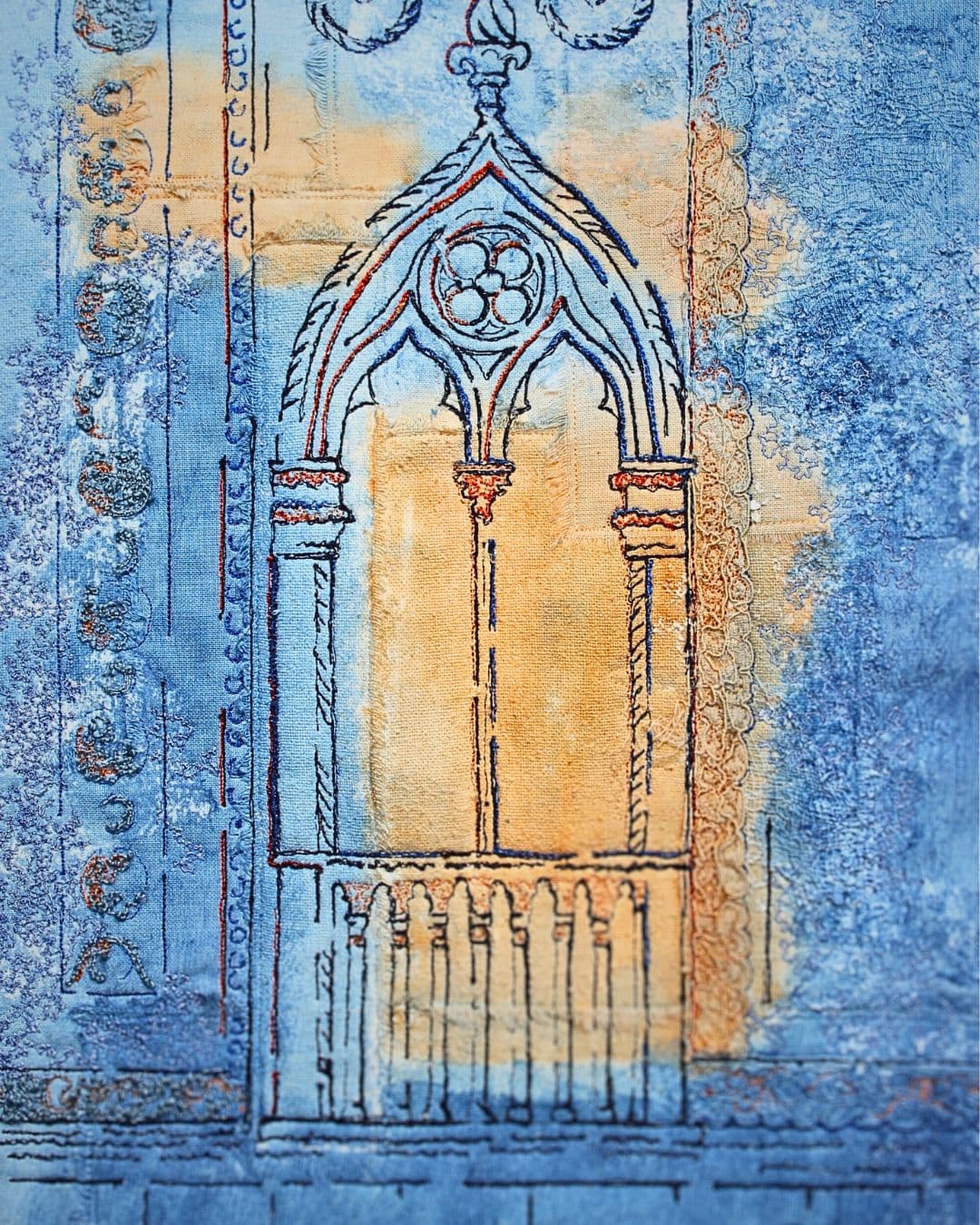
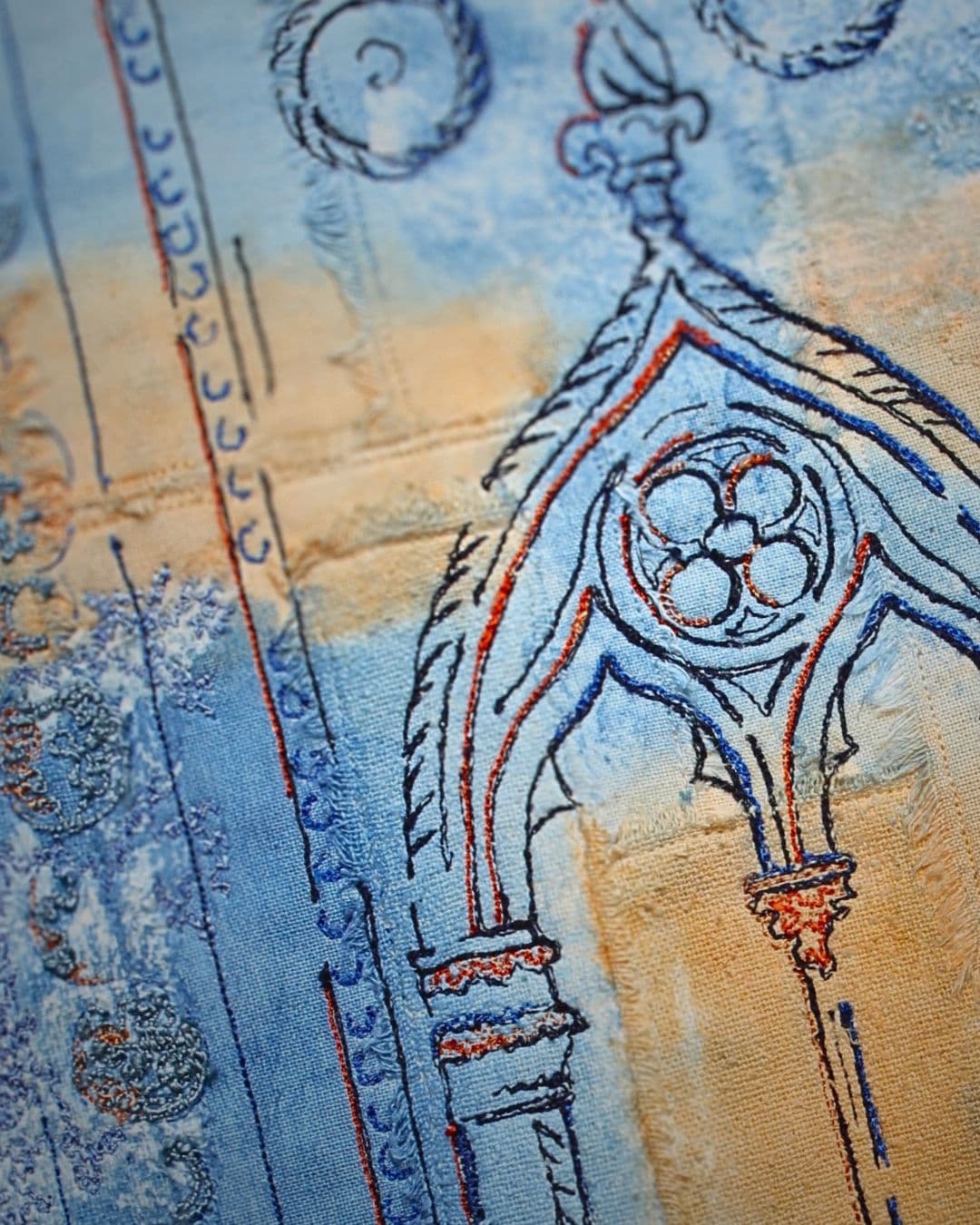
Fabric choices
I prefer using natural fabrics in my art. Calico is my preferred base fabric, and then I’ll select a wide variety of cottons, silks, linens, muslins, scrims, lace and trimmings.
I source most of my fabrics from Whaleys Bradford Ltd., but I also try to use vintage and recycled fabrics whenever I can. Searching charity shops and markets often yields some interesting finds.
I always use freehand machine stitching to attach my initial layers of fabric. I prefer to use a short stitch length which looks more like a sketchy line. When building up the design, I use my machine like a pencil to create line, form and areas of stitched texture. Madeira 40 rayon thread is my favourite.
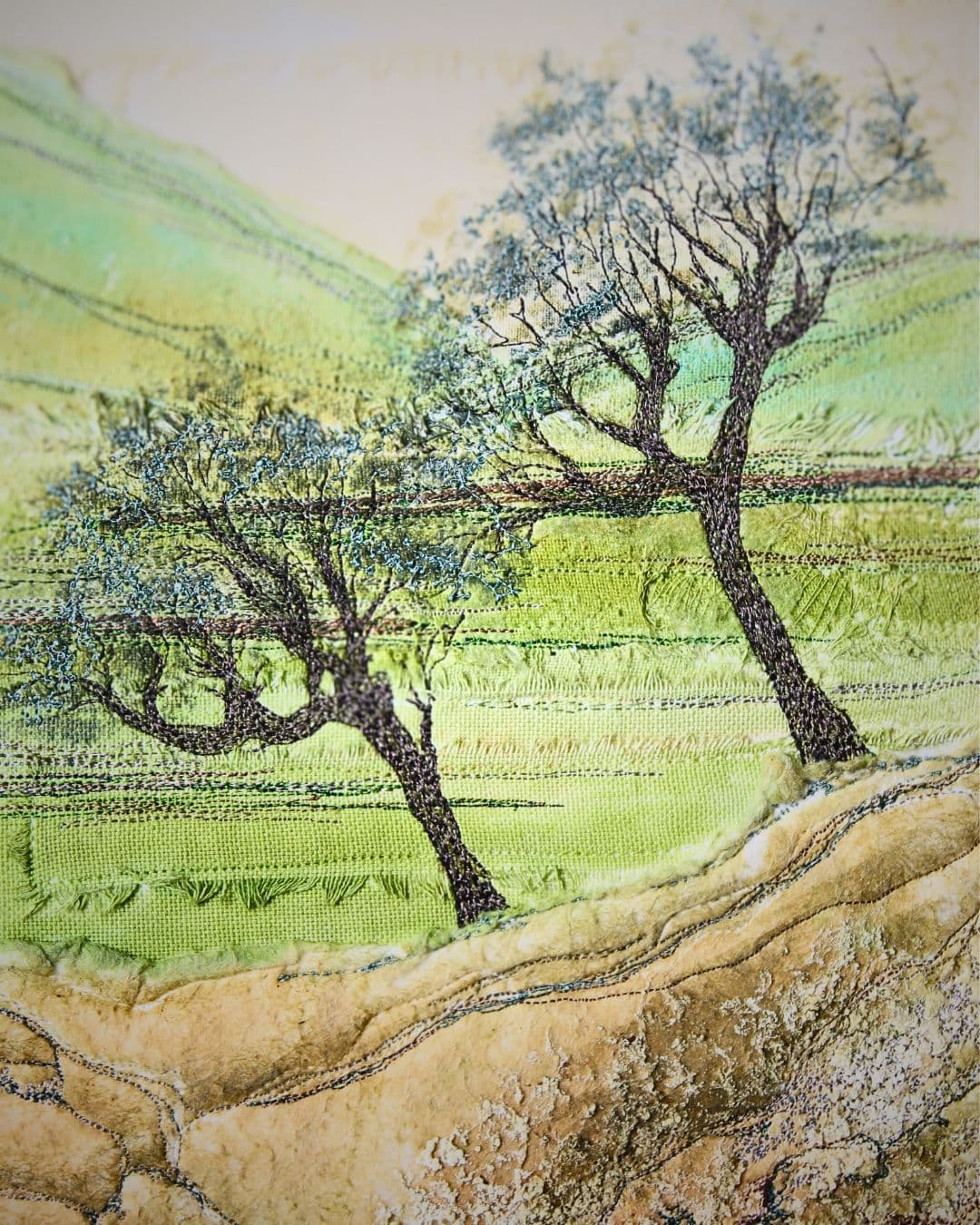
Mark making threads
Even though I print and paint on my fabrics, they remain surprisingly soft once I set the inks with an iron. Stitching is rarely a problem, but I’m always aware of how many layers of fabric will move freely beneath the darning foot.
I use hand stitching to produce isolated marks. I like to use a variety of thread weights depending on the effect I want to create. I have a wide selection from which to choose, including cotton perlé, fine wools, stranded cotton and silk yarns.
For hand stitching I prefer simple stitches, such as seeding, random cross stitch, running and couching. But I mostly stitch for the best effect rather than concentrating on specific stitches.
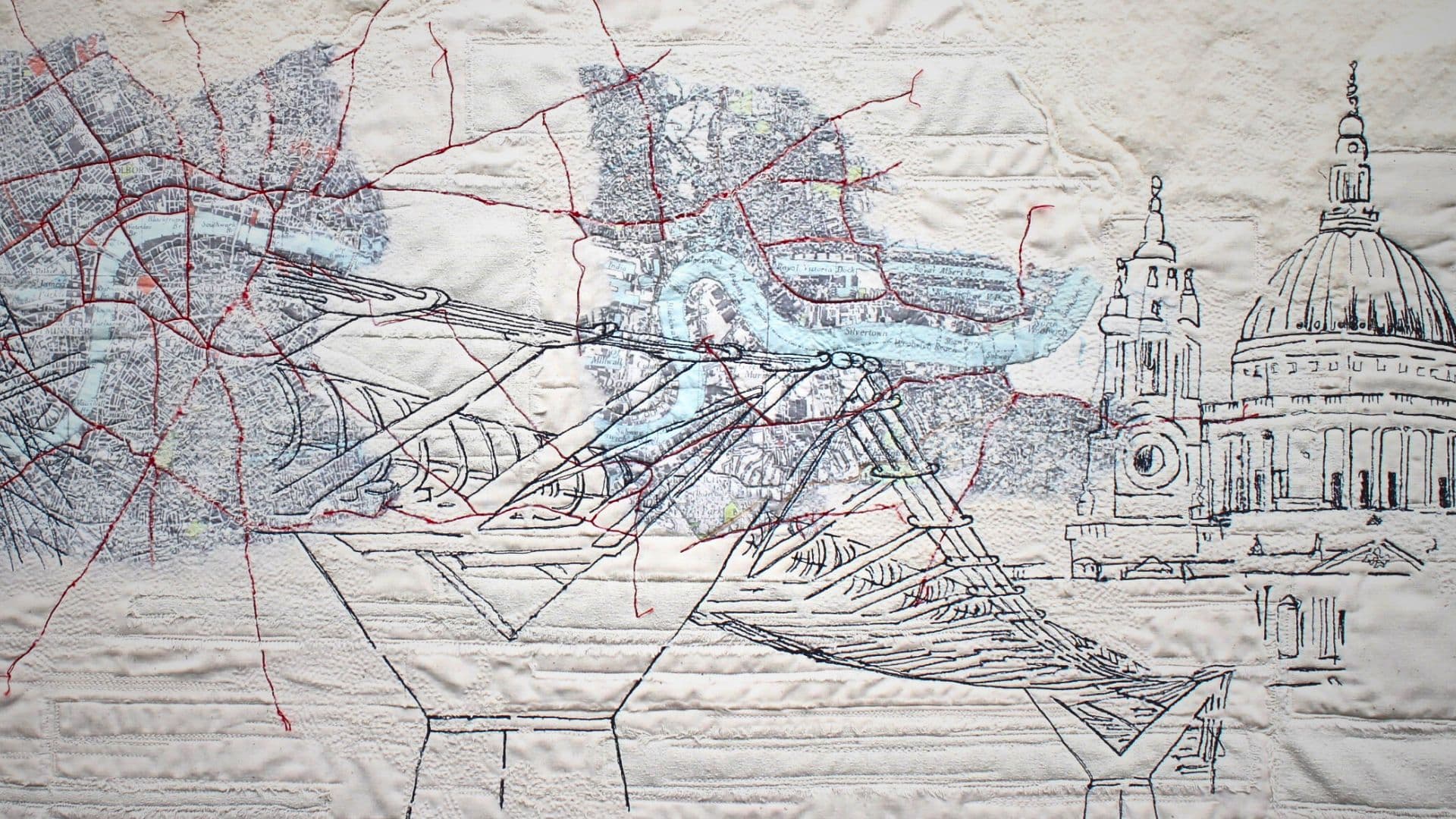
London on the map
My series called A Sense of Place is inspired by places and my journeys. London on the Map incorporates iconic buildings and structures in London. The fabric map depicts central London with the River Thames running through.
Working with my inkjet printer, I first treated the fabric with a BubbleJet 2000 solution. Once dry, I ironed it onto freezer paper and then passed it through the printer.
I used a smooth cotton fabric and placed masking tape over the top edge of the fabric to help it feed smoothly. Keeping the fabrics neutral allowed the colour to come from the map and the applied stitching. The images are stitched with freehand machine embroidery.
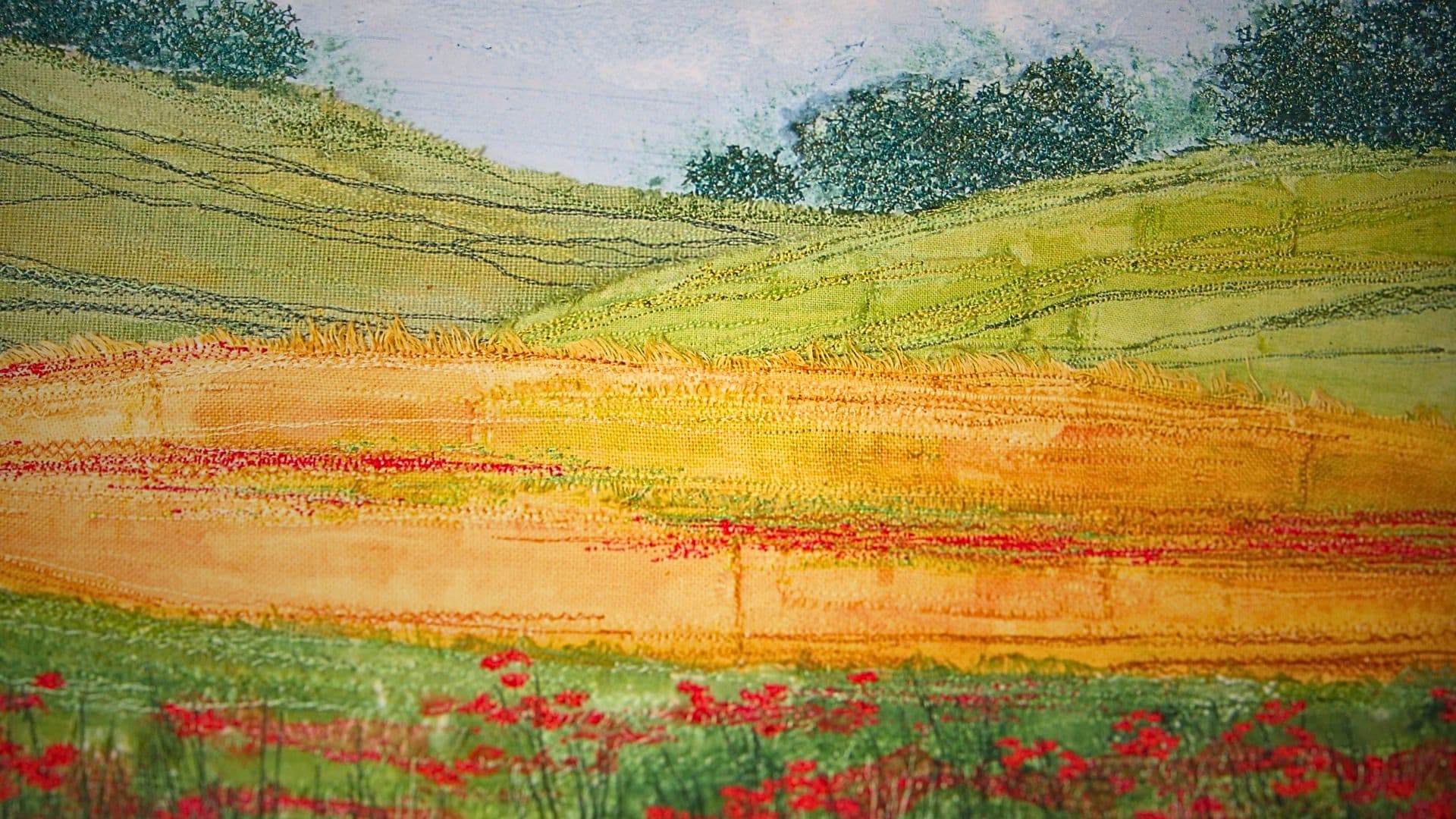
Across the Downs
Living in Sussex close to the South Downs, I find the rolling hills an ideal source of inspiration. Field poppies are often in abundance on the chalk downlands where they create stunning natural displays. I find the contrasting colours within the landscapes very alluring.
In Across the Downs, I layered and stitched natural fabrics before painting them with water-based inks. Normally, when I use my sketchbook to experiment with different colour combinations, the design can become quite abstract. But for this design, I chose to use a more representational colour palette.
The clouds were created by fusing pieces of horticultural fleece onto my white background. That created a resist effect when I painted on top. I sponged colour across the skyline to add a soft, atmospheric backdrop. Then I stitched into the piece to create the trees and introduce texture and depth.
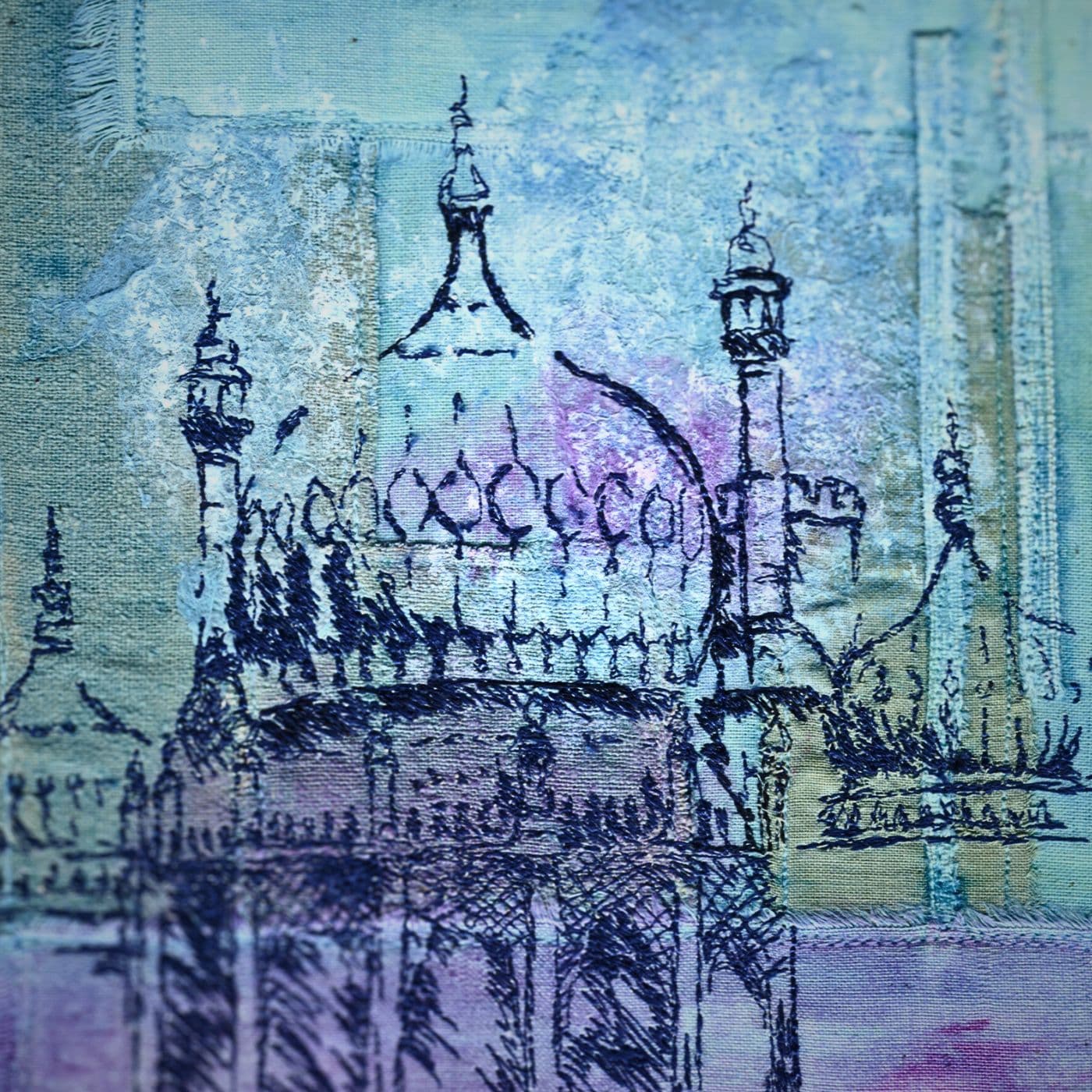
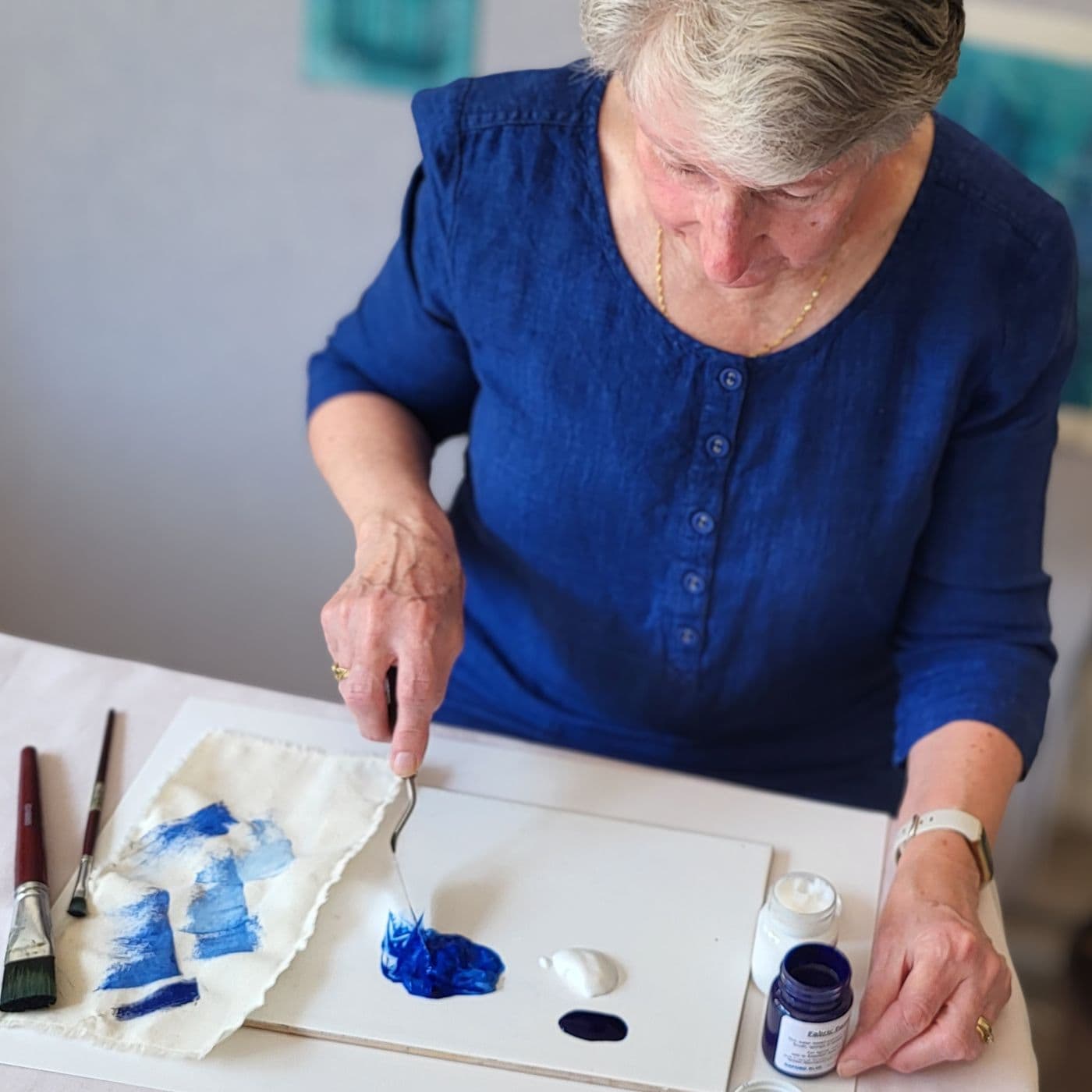
Royal Pavilion
Architecture has always interested me, and I’m constantly taking photos of doors, windows, carvings and crumbly textured surfaces.
The Royal Pavilion in Brighton is especially fascinating because of its eclectic style. The juxtaposition of domes, scalloped arches and intricate stucco work makes it a wonderful resource for exploring patterns and form.
In Royal Pavilion Brighton, I pieced, layered and stitched down calico, cotton silk noil and linen fabrics to create a balance of shapes, texture and tone. Additional surface texture was added using Xpandaprint.
I applied paint and then stitched the outline of the pavilion with dark blue thread. For architectural designs, I tend to trace the image onto Stitch ‘n Tear stabiliser and then stitch from the reverse side with dark thread.
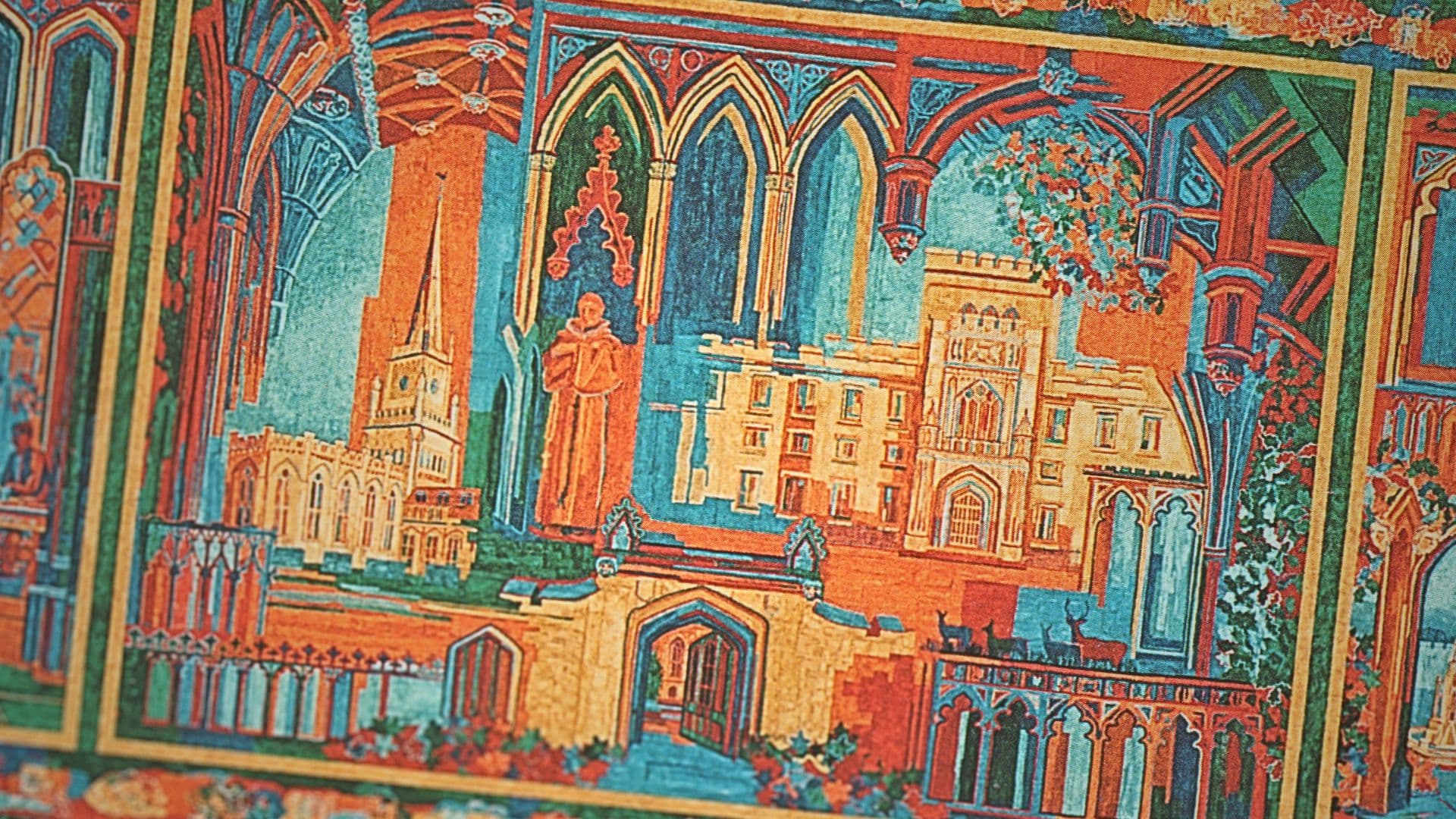
Stitch club workshop
My Stitch Club workshop connects with my love of architecture. Members create a doorway scene that starts with layers of fabric. A paper collage is used to formulate the colour scheme, before they paint the background and stitch the design. Because they’ll be working with a variety of fabrics, interesting effects can be created.
They will also learn a unique reverse stitch transfer method that avoids the use of fabric markers.
I’m eager for members to have fun, learn some new skills, and experiment with layering, painting and stitching techniques. I’m especially hopeful they’ll find the techniques useful in developing their own creative journeys.
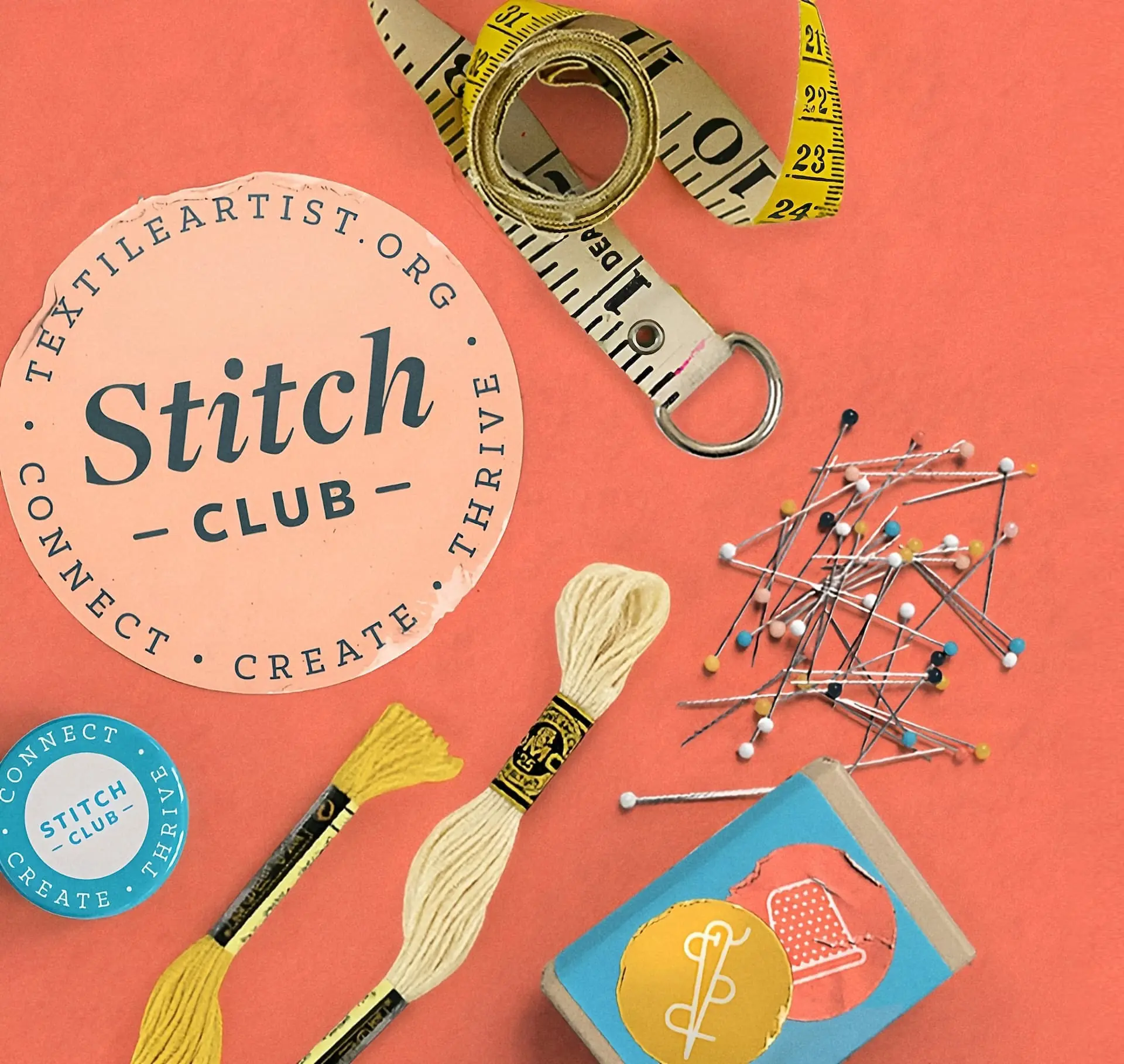
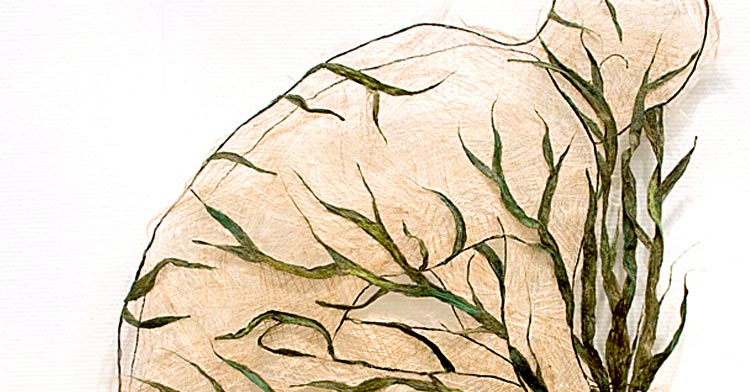
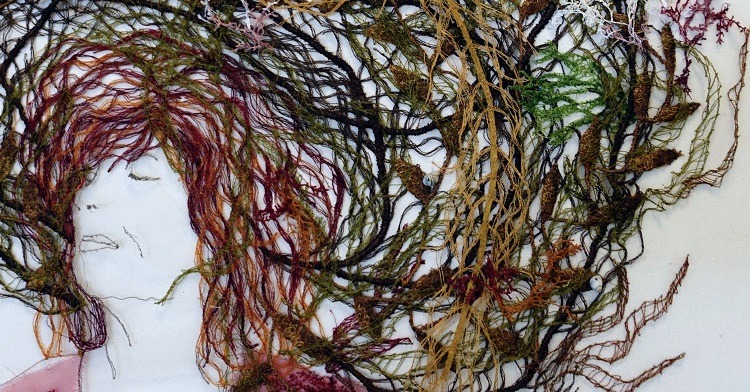
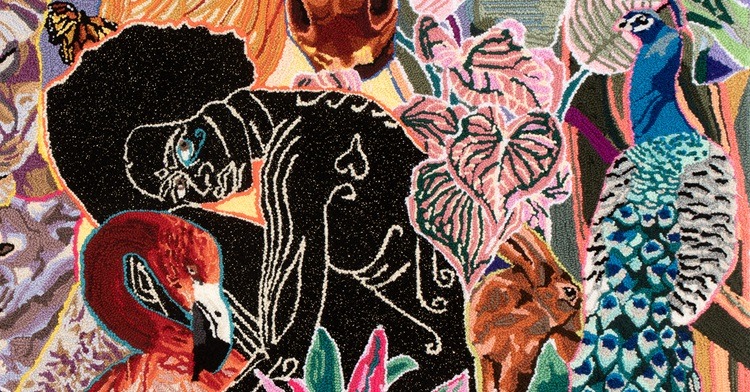
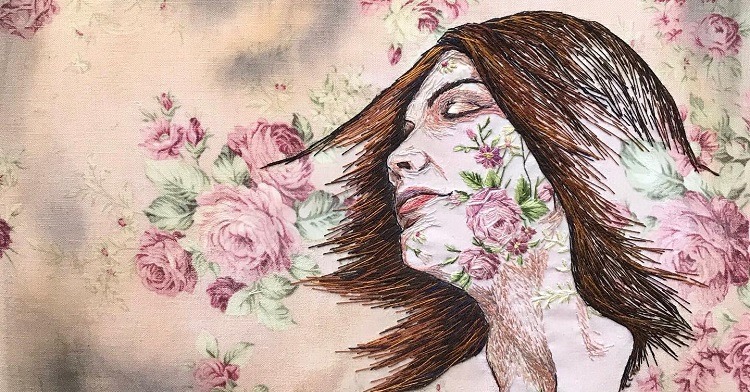
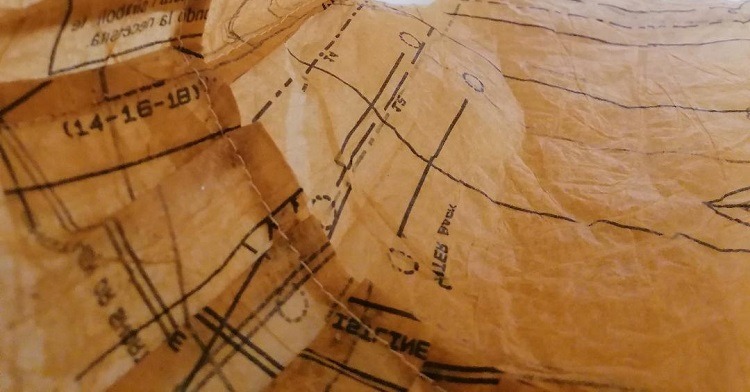
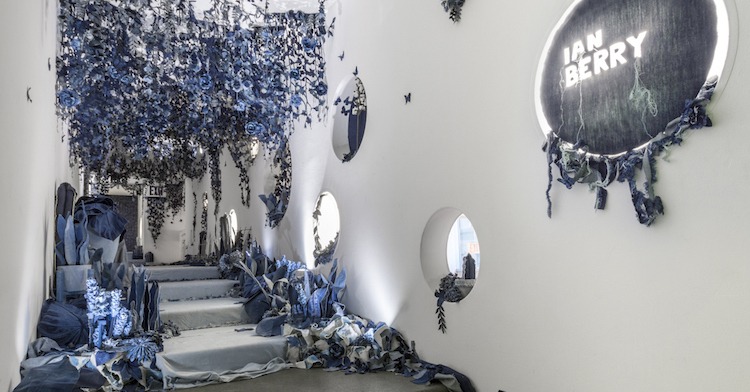
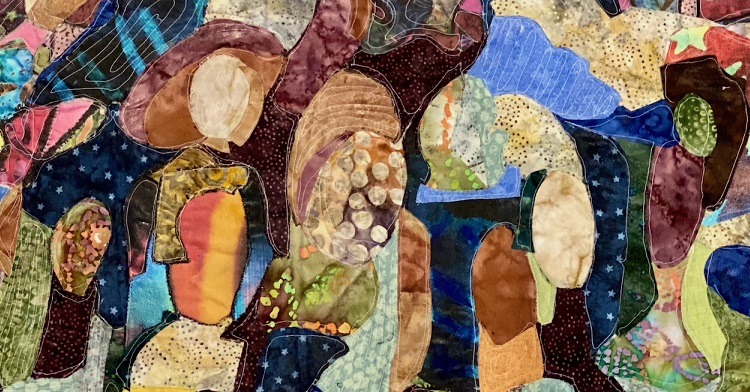
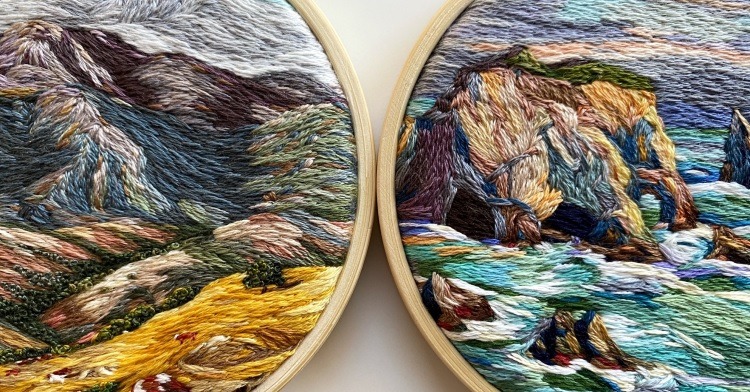
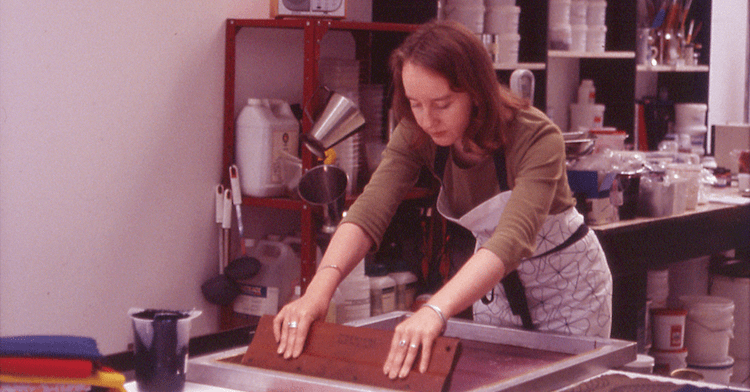
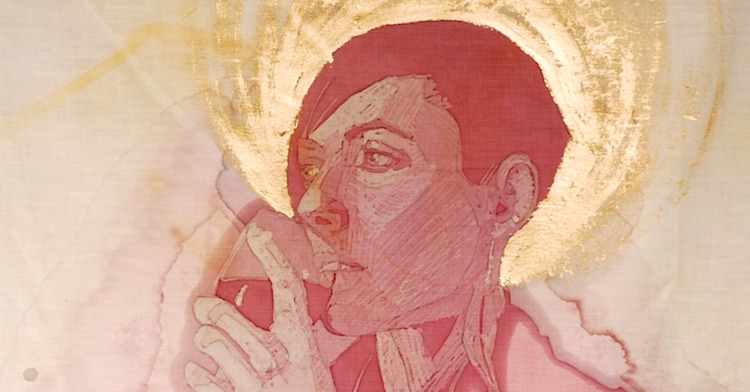
Comments